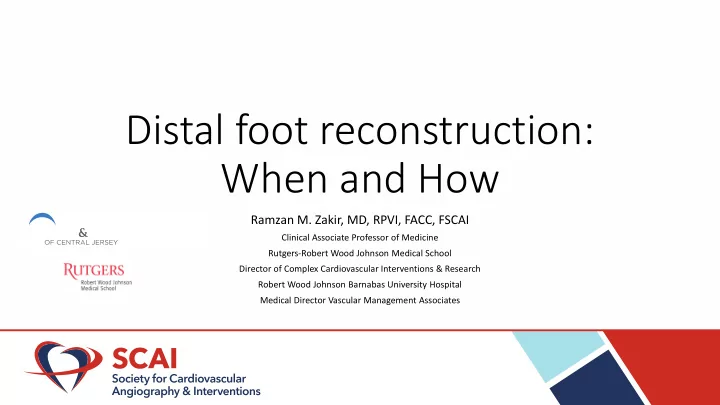

Distal foot reconstruction: When and How Ramzan M. Zakir, MD, RPVI, FACC, FSCAI Clinical Associate Professor of Medicine Rutgers-Robert Wood Johnson Medical School Director of Complex Cardiovascular Interventions & Research Robert Wood Johnson Barnabas University Hospital Medical Director Vascular Management Associates
Disclosures • Speakers Bureau • Boston Scientific • CSI • Philips Medical • Terumo Medical • Abbott • Scientific Advisory Board • Boston Scientific
Indications • Clinical • CLI: Advanced Rutherford Class 5- 6, TUC B-D • Angiographic • Incomplete foot arch • Alternative retrograde access to tibial vessel recanalization
Rationale • Multiple studies have • Elliot J Vasc Surgery 1993;18-881-888 • Johnson J Vasc Surg 1995;22:280-286 demonstrated approximately • Parsons J Vasc Surg 1998;28:1066-1071 15% major amputation in presence of patent-fem distal • Berceli J Vasc Surg 1999;30:499-508 bypass • Treiman J Vasc Surg 2000;31:1110-1118 • Lofberg J Vasc Surg 2001;34:114-121 • Plantar Arch interruption was found in almost all amputees
Solution • Directly perfuse area of ischemia • Pedal Arch reconstruction
Angiosomes Theory
Plantar Arch Revascularization • Initially described in 2006 • Extend the arterial recanalization even to more distal segments with the intention to improved perfusion directly to wound • Alternative to tibial artery occlusions *Graziani BSC Clinical Vision, Issue17, April 2006, Gosling, UK
Conclusions • DAR is not a predictor of good outcomes in diabetic patients undergoing endovascular procedures • Pedal arch patency seems to be a key factor to obtain good outcomes in terms of wound healing and limb salvage
To investigate the clinical implications of pedal artery angioplasty (PAA) for CLI patients presenting with Infrapopliteal and pedal artery diseases Nakama T et al, JACC Cardiovasc Interv, Jan 2017
Study Synopsis • Study Type • Retrospective analysis from mult-center prospectively maintained database (5 clinical sites were included • Study Period • Jan. 2012-Jun. 2015 • Patient enrollment: Jan 2012-Jun. 2014 • Number of patients • 257 patients • Study Patients • CLI patients presenting with de novo infrapopliteal and pedal artery disease, which had ischemic tissue loss or gangrene (Patients categorized into Rutherford 4 were excluded) Nakama T et al, JACC Cardiovasc Interv, Jan 2017
Cause of delayed wound healing Nakama T et al, JACC Cardiovasc Interv, Jan 2017
Primary Outcomes (WH) 211 days P=0.008 365 days Nakama T et al, JACC Cardiovasc Interv, Jan 2017
How • Anatomy • Plantar Loop, imaging views, anomalies • Wire/catheter/balloon and atherectomy techniques • Selective Angiography, Knuckle wire, reverse CART • Ultrasound guidance • Advance Access • Plantar, digital, occluded vessel access
Angiography • Lateral Oblique View • 5 th Meta-tarsal bone must be separated Manzi, M et al. Vascular Imaging of the Foot. RSNA 31(6), 2011
Angiography • Anterior-Posterior View • 1 st Metatarsal Space must be visualized Manzi, M et al. Vascular Imaging of the Foot. RSNA 31(6), 2011
The clinical utility of below ‐ the ‐ ankle angioplasty using “transmetatarsal artery access” in complex cases of CLI Catheterization and Cardiovascular Interventions, Volume: 83, Issue: 1, Pages: 123-129, First published: 20 May 2013, DOI: (10.1002/ccd.24992)
Approach • Review prior angiograms • Antegrade access 5 or 6fr 45 cm sheath • 0.018 support catheter with 0.014 wire, change to 0.014 support catheter when traversing plantar arch • Escalating strategy • True Lumen Crossing • Retrograde true lume crossing • Reverse CART/SAFARI • Digital Acess
Wires • Regalia (Asahi Intecc)- 1g tip with superior steerabilty • Command (Abbott)- stainless steel body and a nitonol 2.8 gm tip • Gladius (Asahi Intecc) – 0.014 3g polymer jacket • Whisper (Abbott Vascular)- 0.8- 1.2 g hydrophilic tip • Fielder FC (Asahi Intecc) – 1.6g hydrophilic tip • Fielder XT (Asahi Intecc) – 0.009 hydrophilic tip; 0.8g • Halberd (Asahi Intecc)- 0.014 12g
Wire Shaping
Intervention • Primarily PTA • Atherectomy has been utilized
Case • 67 year old female with Type 2 DM, non-smoker , cryptogenic cirrhosis, with ischemic rest pain and non-healing toe ulcers, 2 nd and 3 rd digit
Initial Angiography
Initial Angiography
Pedal Arch Wiring
Pedal Arch Ballooning
Final Angiography
Conclusions • Pedal Loop reconstruction can be safely preformed in patients with CLI allowing for improved wound healing • Further studies and registries are warranted to confirm long term benefits and efficacy
Recommend
More recommend